Strategic Growth Plan: Cafepod's Objectives, Funding & Exit Options
VerifiedAdded on 2023/06/10
|11
|3302
|157
Report
AI Summary
This report provides a comprehensive analysis of growth planning for Cafepod Craft Coffee, a UK-based independent coffee business. It utilizes the BCG matrix to assess market share and profitability, and the Ansoff matrix to evaluate growth opportunities such as market penetration, market development, product development, and diversification, concluding that product development is the most suitable strategy for Cafepod. The report also assesses various internal and external funding sources, including bank loans, issuing shares, retained earnings, and owner's capital, recommending bank loans as the most profitable option. Furthermore, it outlines a business plan for growth, including strategic objectives and financial information, and evaluates succession and exit options, detailing their advantages and disadvantages. The vision, mission, goals, and SMART objectives of Cafepod are also discussed, along with its strengths and opportunities for attracting customers and increasing social media engagement.
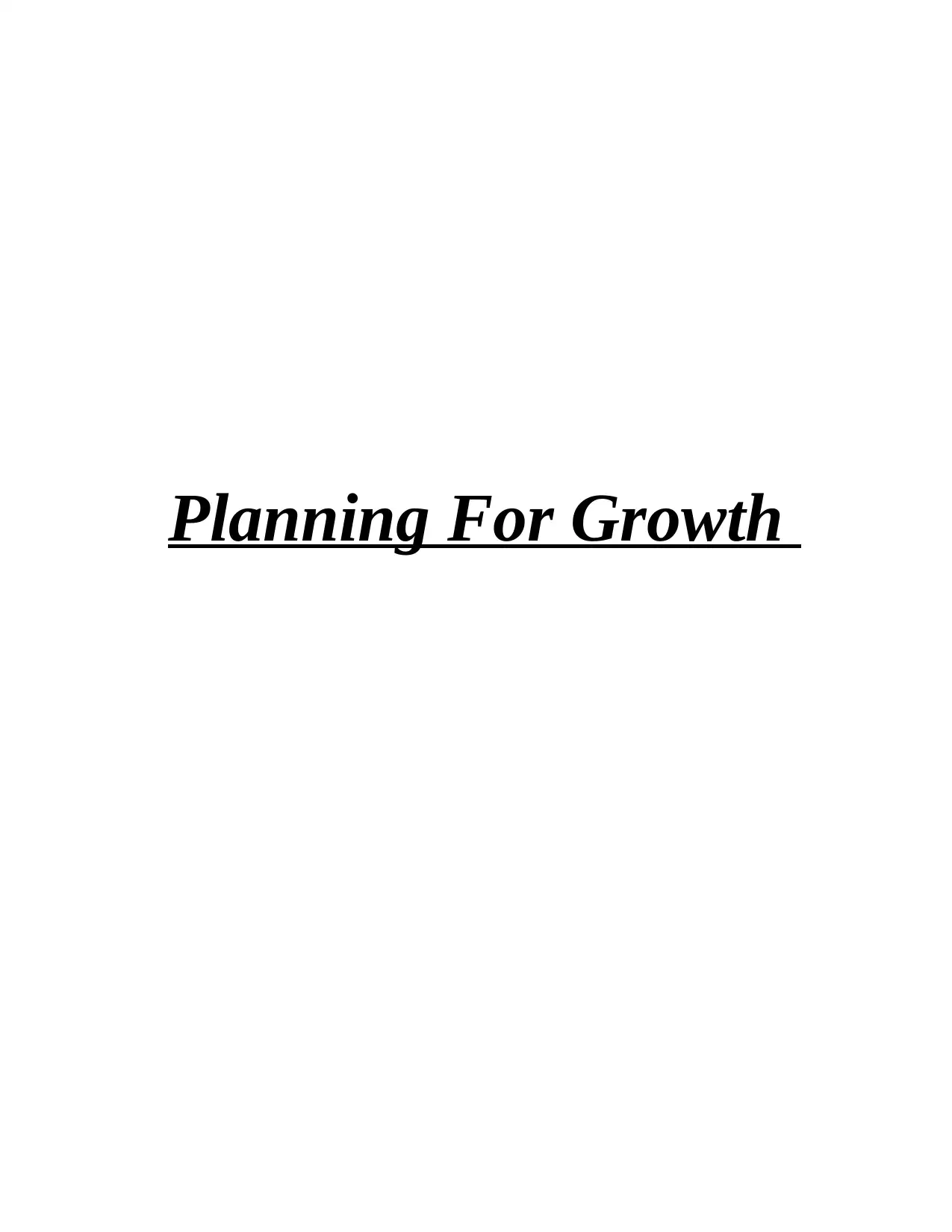
Planning For Growth
Paraphrase This Document
Need a fresh take? Get an instant paraphrase of this document with our AI Paraphraser

Table of Contents
Introduction .....................................................................................................................................3
Main Body.......................................................................................................................................3
P1 Identify key considerations for assessing growth opportunities and justify these
considerations..............................................................................................................................3
P2 evaluate and identify the opportunities for growth applied in an organisation......................4
P3 Assess the possible sources of funding available to an organisation and discuss advantages
and disadvantages of each source...............................................................................................5
P4 Outline a business plan for growth and which include strategic objectives and financial
information for scaling up a business..........................................................................................7
P5 Evaluate the succession and exit option for a small organisation explaining the advantages
and disadvantages of each option................................................................................................8
Conclusion ....................................................................................................................................10
References .....................................................................................................................................10
Introduction .....................................................................................................................................3
Main Body.......................................................................................................................................3
P1 Identify key considerations for assessing growth opportunities and justify these
considerations..............................................................................................................................3
P2 evaluate and identify the opportunities for growth applied in an organisation......................4
P3 Assess the possible sources of funding available to an organisation and discuss advantages
and disadvantages of each source...............................................................................................5
P4 Outline a business plan for growth and which include strategic objectives and financial
information for scaling up a business..........................................................................................7
P5 Evaluate the succession and exit option for a small organisation explaining the advantages
and disadvantages of each option................................................................................................8
Conclusion ....................................................................................................................................10
References .....................................................................................................................................10
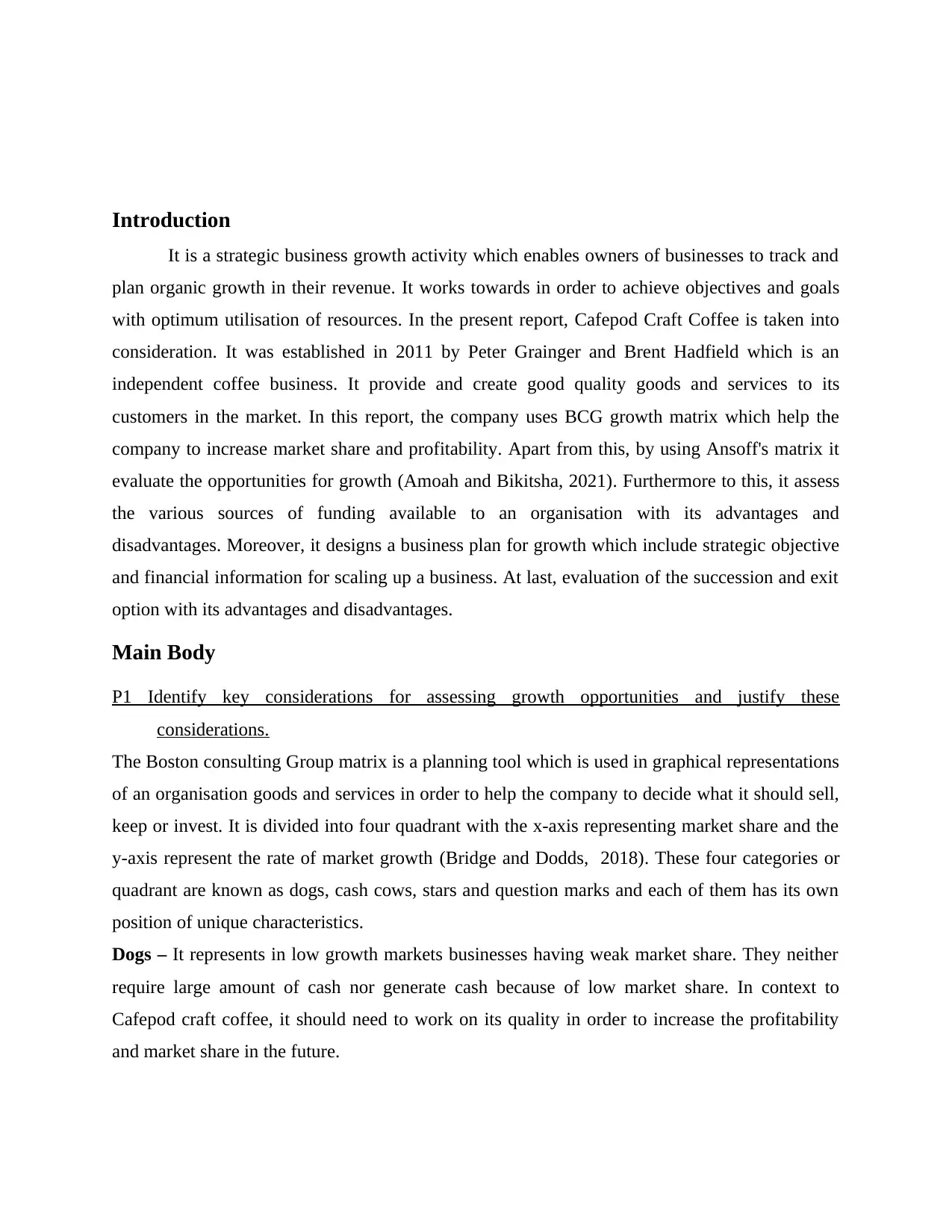
Introduction
It is a strategic business growth activity which enables owners of businesses to track and
plan organic growth in their revenue. It works towards in order to achieve objectives and goals
with optimum utilisation of resources. In the present report, Cafepod Craft Coffee is taken into
consideration. It was established in 2011 by Peter Grainger and Brent Hadfield which is an
independent coffee business. It provide and create good quality goods and services to its
customers in the market. In this report, the company uses BCG growth matrix which help the
company to increase market share and profitability. Apart from this, by using Ansoff's matrix it
evaluate the opportunities for growth (Amoah and Bikitsha, 2021). Furthermore to this, it assess
the various sources of funding available to an organisation with its advantages and
disadvantages. Moreover, it designs a business plan for growth which include strategic objective
and financial information for scaling up a business. At last, evaluation of the succession and exit
option with its advantages and disadvantages.
Main Body
P1 Identify key considerations for assessing growth opportunities and justify these
considerations.
The Boston consulting Group matrix is a planning tool which is used in graphical representations
of an organisation goods and services in order to help the company to decide what it should sell,
keep or invest. It is divided into four quadrant with the x-axis representing market share and the
y-axis represent the rate of market growth (Bridge and Dodds, 2018). These four categories or
quadrant are known as dogs, cash cows, stars and question marks and each of them has its own
position of unique characteristics.
Dogs – It represents in low growth markets businesses having weak market share. They neither
require large amount of cash nor generate cash because of low market share. In context to
Cafepod craft coffee, it should need to work on its quality in order to increase the profitability
and market share in the future.
It is a strategic business growth activity which enables owners of businesses to track and
plan organic growth in their revenue. It works towards in order to achieve objectives and goals
with optimum utilisation of resources. In the present report, Cafepod Craft Coffee is taken into
consideration. It was established in 2011 by Peter Grainger and Brent Hadfield which is an
independent coffee business. It provide and create good quality goods and services to its
customers in the market. In this report, the company uses BCG growth matrix which help the
company to increase market share and profitability. Apart from this, by using Ansoff's matrix it
evaluate the opportunities for growth (Amoah and Bikitsha, 2021). Furthermore to this, it assess
the various sources of funding available to an organisation with its advantages and
disadvantages. Moreover, it designs a business plan for growth which include strategic objective
and financial information for scaling up a business. At last, evaluation of the succession and exit
option with its advantages and disadvantages.
Main Body
P1 Identify key considerations for assessing growth opportunities and justify these
considerations.
The Boston consulting Group matrix is a planning tool which is used in graphical representations
of an organisation goods and services in order to help the company to decide what it should sell,
keep or invest. It is divided into four quadrant with the x-axis representing market share and the
y-axis represent the rate of market growth (Bridge and Dodds, 2018). These four categories or
quadrant are known as dogs, cash cows, stars and question marks and each of them has its own
position of unique characteristics.
Dogs – It represents in low growth markets businesses having weak market share. They neither
require large amount of cash nor generate cash because of low market share. In context to
Cafepod craft coffee, it should need to work on its quality in order to increase the profitability
and market share in the future.
⊘ This is a preview!⊘
Do you want full access?
Subscribe today to unlock all pages.

Trusted by 1+ million students worldwide
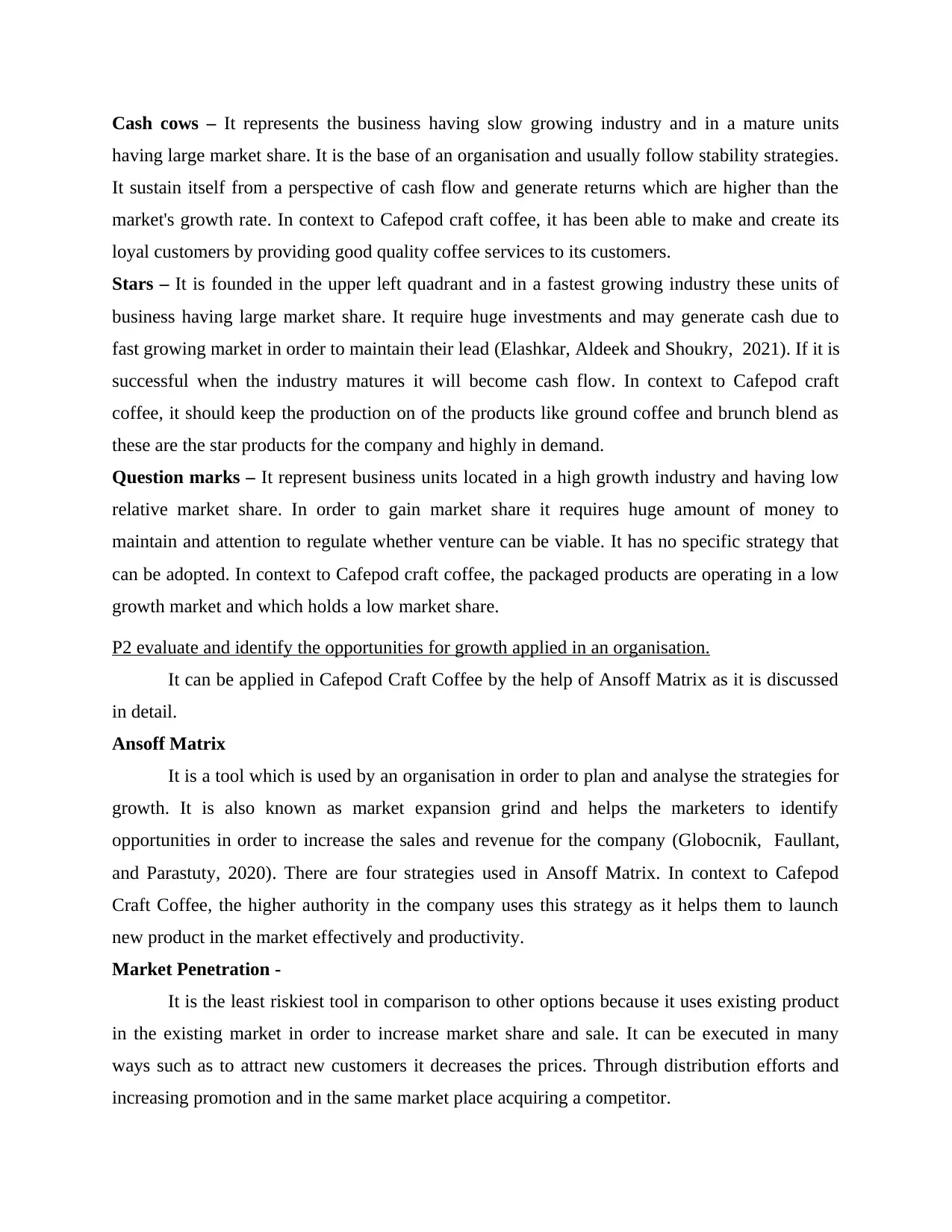
Cash cows – It represents the business having slow growing industry and in a mature units
having large market share. It is the base of an organisation and usually follow stability strategies.
It sustain itself from a perspective of cash flow and generate returns which are higher than the
market's growth rate. In context to Cafepod craft coffee, it has been able to make and create its
loyal customers by providing good quality coffee services to its customers.
Stars – It is founded in the upper left quadrant and in a fastest growing industry these units of
business having large market share. It require huge investments and may generate cash due to
fast growing market in order to maintain their lead (Elashkar, Aldeek and Shoukry, 2021). If it is
successful when the industry matures it will become cash flow. In context to Cafepod craft
coffee, it should keep the production on of the products like ground coffee and brunch blend as
these are the star products for the company and highly in demand.
Question marks – It represent business units located in a high growth industry and having low
relative market share. In order to gain market share it requires huge amount of money to
maintain and attention to regulate whether venture can be viable. It has no specific strategy that
can be adopted. In context to Cafepod craft coffee, the packaged products are operating in a low
growth market and which holds a low market share.
P2 evaluate and identify the opportunities for growth applied in an organisation.
It can be applied in Cafepod Craft Coffee by the help of Ansoff Matrix as it is discussed
in detail.
Ansoff Matrix
It is a tool which is used by an organisation in order to plan and analyse the strategies for
growth. It is also known as market expansion grind and helps the marketers to identify
opportunities in order to increase the sales and revenue for the company (Globocnik, Faullant,
and Parastuty, 2020). There are four strategies used in Ansoff Matrix. In context to Cafepod
Craft Coffee, the higher authority in the company uses this strategy as it helps them to launch
new product in the market effectively and productivity.
Market Penetration -
It is the least riskiest tool in comparison to other options because it uses existing product
in the existing market in order to increase market share and sale. It can be executed in many
ways such as to attract new customers it decreases the prices. Through distribution efforts and
increasing promotion and in the same market place acquiring a competitor.
having large market share. It is the base of an organisation and usually follow stability strategies.
It sustain itself from a perspective of cash flow and generate returns which are higher than the
market's growth rate. In context to Cafepod craft coffee, it has been able to make and create its
loyal customers by providing good quality coffee services to its customers.
Stars – It is founded in the upper left quadrant and in a fastest growing industry these units of
business having large market share. It require huge investments and may generate cash due to
fast growing market in order to maintain their lead (Elashkar, Aldeek and Shoukry, 2021). If it is
successful when the industry matures it will become cash flow. In context to Cafepod craft
coffee, it should keep the production on of the products like ground coffee and brunch blend as
these are the star products for the company and highly in demand.
Question marks – It represent business units located in a high growth industry and having low
relative market share. In order to gain market share it requires huge amount of money to
maintain and attention to regulate whether venture can be viable. It has no specific strategy that
can be adopted. In context to Cafepod craft coffee, the packaged products are operating in a low
growth market and which holds a low market share.
P2 evaluate and identify the opportunities for growth applied in an organisation.
It can be applied in Cafepod Craft Coffee by the help of Ansoff Matrix as it is discussed
in detail.
Ansoff Matrix
It is a tool which is used by an organisation in order to plan and analyse the strategies for
growth. It is also known as market expansion grind and helps the marketers to identify
opportunities in order to increase the sales and revenue for the company (Globocnik, Faullant,
and Parastuty, 2020). There are four strategies used in Ansoff Matrix. In context to Cafepod
Craft Coffee, the higher authority in the company uses this strategy as it helps them to launch
new product in the market effectively and productivity.
Market Penetration -
It is the least riskiest tool in comparison to other options because it uses existing product
in the existing market in order to increase market share and sale. It can be executed in many
ways such as to attract new customers it decreases the prices. Through distribution efforts and
increasing promotion and in the same market place acquiring a competitor.
Paraphrase This Document
Need a fresh take? Get an instant paraphrase of this document with our AI Paraphraser
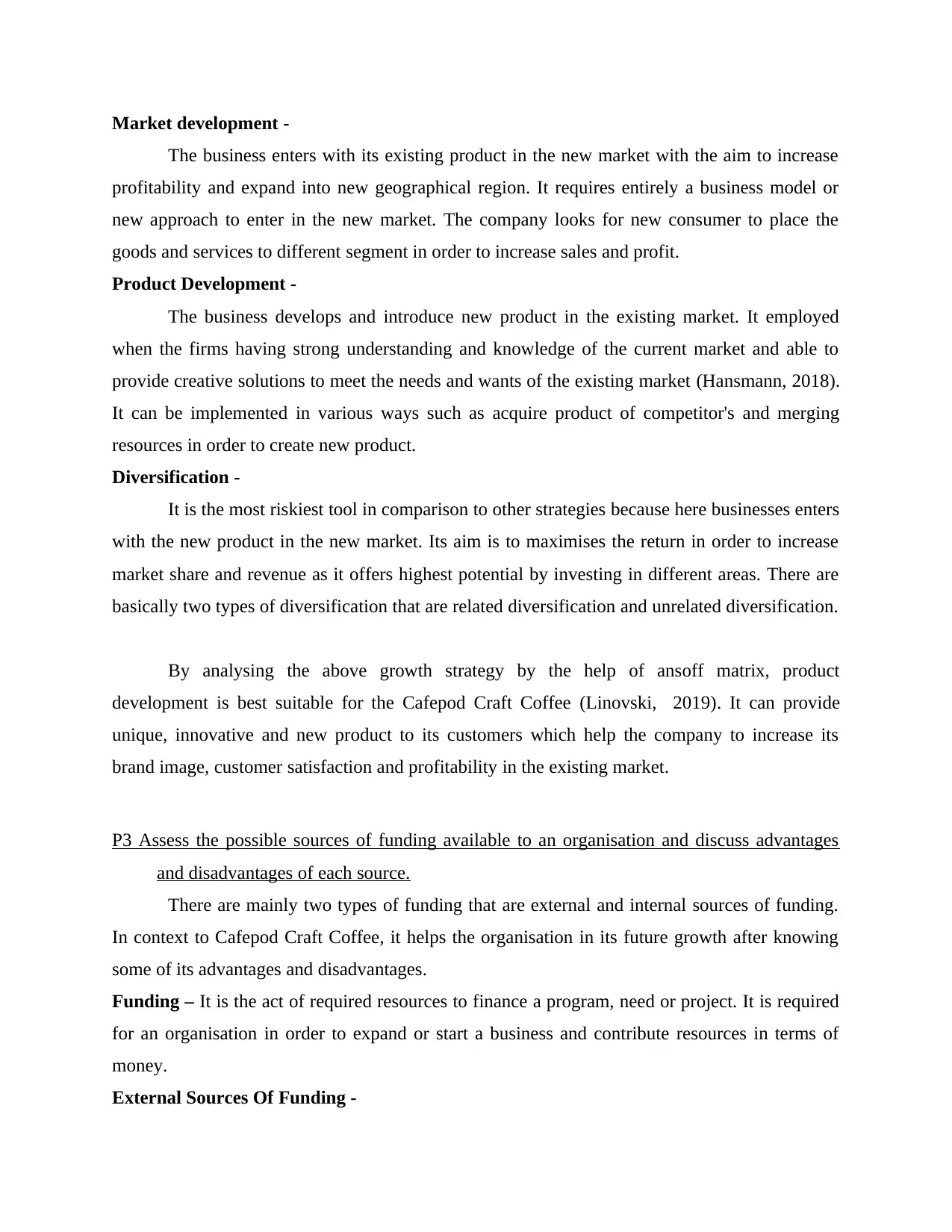
Market development -
The business enters with its existing product in the new market with the aim to increase
profitability and expand into new geographical region. It requires entirely a business model or
new approach to enter in the new market. The company looks for new consumer to place the
goods and services to different segment in order to increase sales and profit.
Product Development -
The business develops and introduce new product in the existing market. It employed
when the firms having strong understanding and knowledge of the current market and able to
provide creative solutions to meet the needs and wants of the existing market (Hansmann, 2018).
It can be implemented in various ways such as acquire product of competitor's and merging
resources in order to create new product.
Diversification -
It is the most riskiest tool in comparison to other strategies because here businesses enters
with the new product in the new market. Its aim is to maximises the return in order to increase
market share and revenue as it offers highest potential by investing in different areas. There are
basically two types of diversification that are related diversification and unrelated diversification.
By analysing the above growth strategy by the help of ansoff matrix, product
development is best suitable for the Cafepod Craft Coffee (Linovski, 2019). It can provide
unique, innovative and new product to its customers which help the company to increase its
brand image, customer satisfaction and profitability in the existing market.
P3 Assess the possible sources of funding available to an organisation and discuss advantages
and disadvantages of each source.
There are mainly two types of funding that are external and internal sources of funding.
In context to Cafepod Craft Coffee, it helps the organisation in its future growth after knowing
some of its advantages and disadvantages.
Funding – It is the act of required resources to finance a program, need or project. It is required
for an organisation in order to expand or start a business and contribute resources in terms of
money.
External Sources Of Funding -
The business enters with its existing product in the new market with the aim to increase
profitability and expand into new geographical region. It requires entirely a business model or
new approach to enter in the new market. The company looks for new consumer to place the
goods and services to different segment in order to increase sales and profit.
Product Development -
The business develops and introduce new product in the existing market. It employed
when the firms having strong understanding and knowledge of the current market and able to
provide creative solutions to meet the needs and wants of the existing market (Hansmann, 2018).
It can be implemented in various ways such as acquire product of competitor's and merging
resources in order to create new product.
Diversification -
It is the most riskiest tool in comparison to other strategies because here businesses enters
with the new product in the new market. Its aim is to maximises the return in order to increase
market share and revenue as it offers highest potential by investing in different areas. There are
basically two types of diversification that are related diversification and unrelated diversification.
By analysing the above growth strategy by the help of ansoff matrix, product
development is best suitable for the Cafepod Craft Coffee (Linovski, 2019). It can provide
unique, innovative and new product to its customers which help the company to increase its
brand image, customer satisfaction and profitability in the existing market.
P3 Assess the possible sources of funding available to an organisation and discuss advantages
and disadvantages of each source.
There are mainly two types of funding that are external and internal sources of funding.
In context to Cafepod Craft Coffee, it helps the organisation in its future growth after knowing
some of its advantages and disadvantages.
Funding – It is the act of required resources to finance a program, need or project. It is required
for an organisation in order to expand or start a business and contribute resources in terms of
money.
External Sources Of Funding -
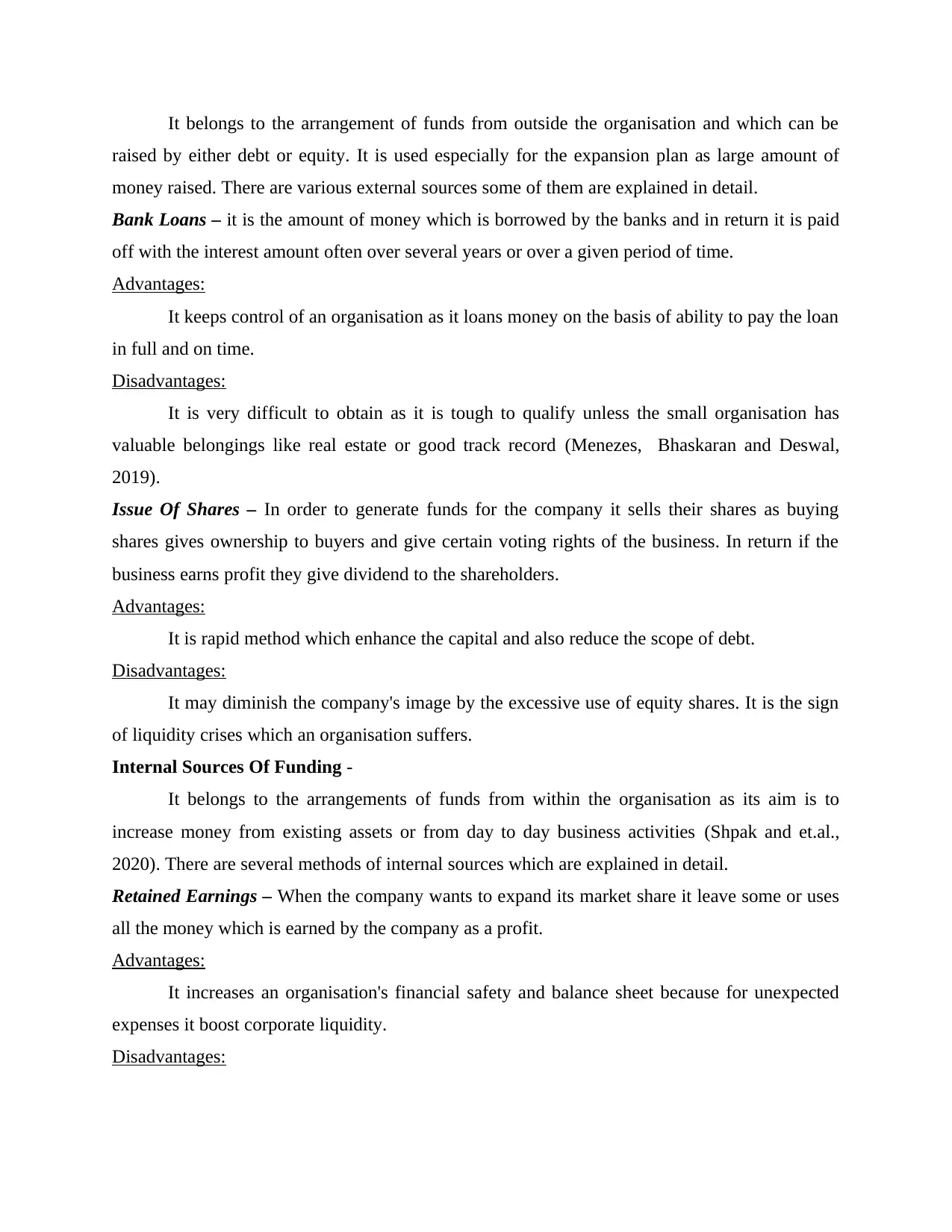
It belongs to the arrangement of funds from outside the organisation and which can be
raised by either debt or equity. It is used especially for the expansion plan as large amount of
money raised. There are various external sources some of them are explained in detail.
Bank Loans – it is the amount of money which is borrowed by the banks and in return it is paid
off with the interest amount often over several years or over a given period of time.
Advantages:
It keeps control of an organisation as it loans money on the basis of ability to pay the loan
in full and on time.
Disadvantages:
It is very difficult to obtain as it is tough to qualify unless the small organisation has
valuable belongings like real estate or good track record (Menezes, Bhaskaran and Deswal,
2019).
Issue Of Shares – In order to generate funds for the company it sells their shares as buying
shares gives ownership to buyers and give certain voting rights of the business. In return if the
business earns profit they give dividend to the shareholders.
Advantages:
It is rapid method which enhance the capital and also reduce the scope of debt.
Disadvantages:
It may diminish the company's image by the excessive use of equity shares. It is the sign
of liquidity crises which an organisation suffers.
Internal Sources Of Funding -
It belongs to the arrangements of funds from within the organisation as its aim is to
increase money from existing assets or from day to day business activities (Shpak and et.al.,
2020). There are several methods of internal sources which are explained in detail.
Retained Earnings – When the company wants to expand its market share it leave some or uses
all the money which is earned by the company as a profit.
Advantages:
It increases an organisation's financial safety and balance sheet because for unexpected
expenses it boost corporate liquidity.
Disadvantages:
raised by either debt or equity. It is used especially for the expansion plan as large amount of
money raised. There are various external sources some of them are explained in detail.
Bank Loans – it is the amount of money which is borrowed by the banks and in return it is paid
off with the interest amount often over several years or over a given period of time.
Advantages:
It keeps control of an organisation as it loans money on the basis of ability to pay the loan
in full and on time.
Disadvantages:
It is very difficult to obtain as it is tough to qualify unless the small organisation has
valuable belongings like real estate or good track record (Menezes, Bhaskaran and Deswal,
2019).
Issue Of Shares – In order to generate funds for the company it sells their shares as buying
shares gives ownership to buyers and give certain voting rights of the business. In return if the
business earns profit they give dividend to the shareholders.
Advantages:
It is rapid method which enhance the capital and also reduce the scope of debt.
Disadvantages:
It may diminish the company's image by the excessive use of equity shares. It is the sign
of liquidity crises which an organisation suffers.
Internal Sources Of Funding -
It belongs to the arrangements of funds from within the organisation as its aim is to
increase money from existing assets or from day to day business activities (Shpak and et.al.,
2020). There are several methods of internal sources which are explained in detail.
Retained Earnings – When the company wants to expand its market share it leave some or uses
all the money which is earned by the company as a profit.
Advantages:
It increases an organisation's financial safety and balance sheet because for unexpected
expenses it boost corporate liquidity.
Disadvantages:
⊘ This is a preview!⊘
Do you want full access?
Subscribe today to unlock all pages.

Trusted by 1+ million students worldwide

It provides low rate of dividend to its shareholders which creates dissatisfaction among
them and negatively affect the market value of the shares.
Owners Capital – It belongs to the owner's investment in an organisation from their personal
savings in terms of money. It did not cost the business as no interest imposed by the owner.
Advantages:
It is the convenient and quick method as no interest need to be paid by the company.
Disadvantages:
Once the money is gone it is gone as the owner may may require or need money for
personal use also and not have much savings (Sparkman, 2018).
Evaluation – By evaluating the above sources of funding, it has been analysed that bank loan of
external source is more profitable for the company Cafepod. It helps to increase growth and
expand business safely and effectively. It provides emergency relief, uneven cash flows and fund
marketing campaigns for the business.
P4 Outline a business plan for growth and which include strategic objectives and financial
information for scaling up a business.
Business Plan – It is the basic written document which is used to identify, describe and analyse
opportunities for the business and how it plans to achieve and increase its goals. It outlines a
company's objectives, financial forecast, market research and go to market plan as it helps to
increase market share and profitability.
Vision :
It assist to give the business direction and look towards future goals. Cafepod Craft
Coffee's vision is to become top company of coffee in UK and achieve its objectives in the long
run with wide range of products (Tetteh and et.al., 2022).
Mission :
Its mission is to provide leisure, best quality products and services at an affordable price
in friendly and comfortable environment to consumers.
Goals :
The goal of the company is to provide good working environment for both the employees
and consumers so that they can be treated with respect and dignity and able to provide
sustainable income. Its goal is also to provide good quality goods and services at an affordable
prices to its customers.
them and negatively affect the market value of the shares.
Owners Capital – It belongs to the owner's investment in an organisation from their personal
savings in terms of money. It did not cost the business as no interest imposed by the owner.
Advantages:
It is the convenient and quick method as no interest need to be paid by the company.
Disadvantages:
Once the money is gone it is gone as the owner may may require or need money for
personal use also and not have much savings (Sparkman, 2018).
Evaluation – By evaluating the above sources of funding, it has been analysed that bank loan of
external source is more profitable for the company Cafepod. It helps to increase growth and
expand business safely and effectively. It provides emergency relief, uneven cash flows and fund
marketing campaigns for the business.
P4 Outline a business plan for growth and which include strategic objectives and financial
information for scaling up a business.
Business Plan – It is the basic written document which is used to identify, describe and analyse
opportunities for the business and how it plans to achieve and increase its goals. It outlines a
company's objectives, financial forecast, market research and go to market plan as it helps to
increase market share and profitability.
Vision :
It assist to give the business direction and look towards future goals. Cafepod Craft
Coffee's vision is to become top company of coffee in UK and achieve its objectives in the long
run with wide range of products (Tetteh and et.al., 2022).
Mission :
Its mission is to provide leisure, best quality products and services at an affordable price
in friendly and comfortable environment to consumers.
Goals :
The goal of the company is to provide good working environment for both the employees
and consumers so that they can be treated with respect and dignity and able to provide
sustainable income. Its goal is also to provide good quality goods and services at an affordable
prices to its customers.
Paraphrase This Document
Need a fresh take? Get an instant paraphrase of this document with our AI Paraphraser
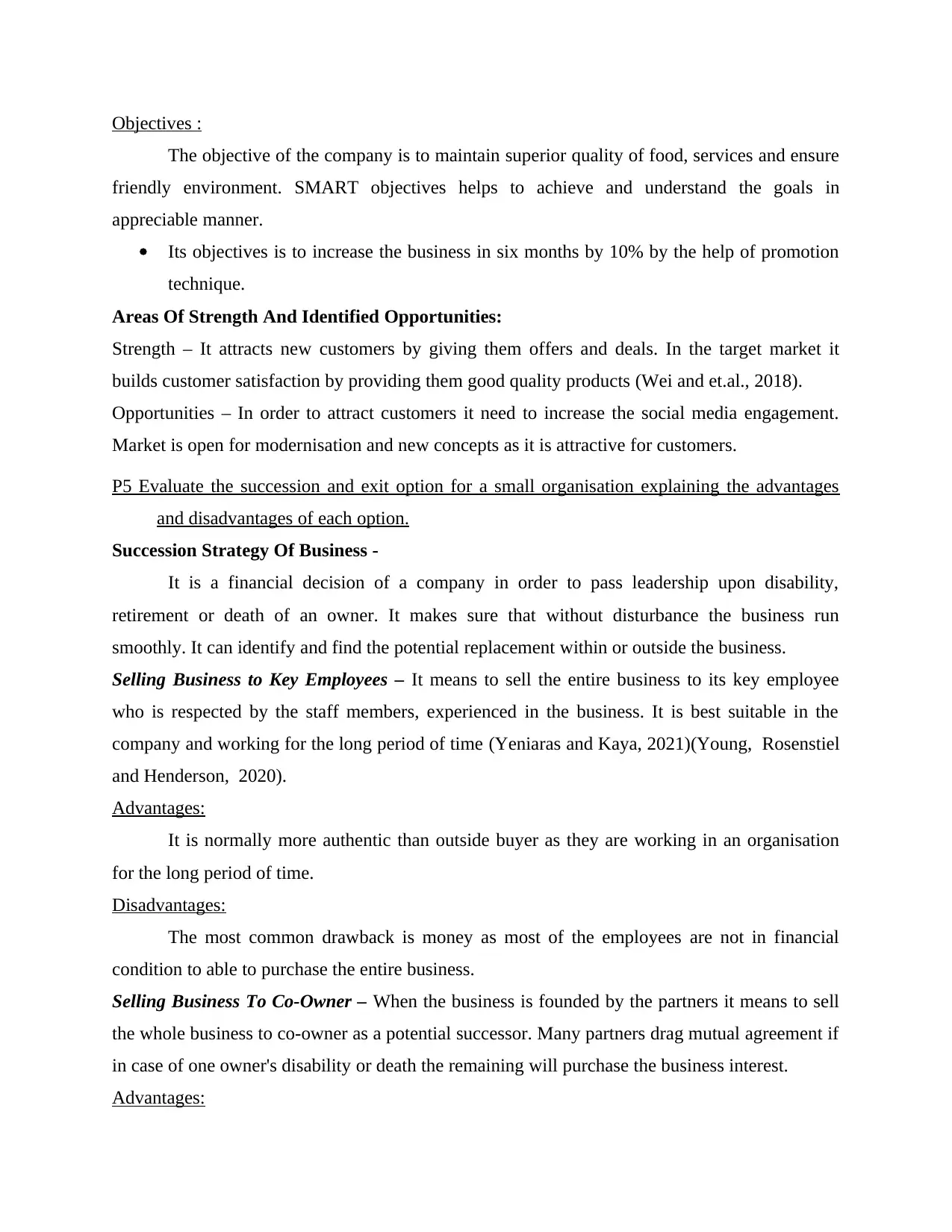
Objectives :
The objective of the company is to maintain superior quality of food, services and ensure
friendly environment. SMART objectives helps to achieve and understand the goals in
appreciable manner.
Its objectives is to increase the business in six months by 10% by the help of promotion
technique.
Areas Of Strength And Identified Opportunities:
Strength – It attracts new customers by giving them offers and deals. In the target market it
builds customer satisfaction by providing them good quality products (Wei and et.al., 2018).
Opportunities – In order to attract customers it need to increase the social media engagement.
Market is open for modernisation and new concepts as it is attractive for customers.
P5 Evaluate the succession and exit option for a small organisation explaining the advantages
and disadvantages of each option.
Succession Strategy Of Business -
It is a financial decision of a company in order to pass leadership upon disability,
retirement or death of an owner. It makes sure that without disturbance the business run
smoothly. It can identify and find the potential replacement within or outside the business.
Selling Business to Key Employees – It means to sell the entire business to its key employee
who is respected by the staff members, experienced in the business. It is best suitable in the
company and working for the long period of time (Yeniaras and Kaya, 2021)(Young, Rosenstiel
and Henderson, 2020).
Advantages:
It is normally more authentic than outside buyer as they are working in an organisation
for the long period of time.
Disadvantages:
The most common drawback is money as most of the employees are not in financial
condition to able to purchase the entire business.
Selling Business To Co-Owner – When the business is founded by the partners it means to sell
the whole business to co-owner as a potential successor. Many partners drag mutual agreement if
in case of one owner's disability or death the remaining will purchase the business interest.
Advantages:
The objective of the company is to maintain superior quality of food, services and ensure
friendly environment. SMART objectives helps to achieve and understand the goals in
appreciable manner.
Its objectives is to increase the business in six months by 10% by the help of promotion
technique.
Areas Of Strength And Identified Opportunities:
Strength – It attracts new customers by giving them offers and deals. In the target market it
builds customer satisfaction by providing them good quality products (Wei and et.al., 2018).
Opportunities – In order to attract customers it need to increase the social media engagement.
Market is open for modernisation and new concepts as it is attractive for customers.
P5 Evaluate the succession and exit option for a small organisation explaining the advantages
and disadvantages of each option.
Succession Strategy Of Business -
It is a financial decision of a company in order to pass leadership upon disability,
retirement or death of an owner. It makes sure that without disturbance the business run
smoothly. It can identify and find the potential replacement within or outside the business.
Selling Business to Key Employees – It means to sell the entire business to its key employee
who is respected by the staff members, experienced in the business. It is best suitable in the
company and working for the long period of time (Yeniaras and Kaya, 2021)(Young, Rosenstiel
and Henderson, 2020).
Advantages:
It is normally more authentic than outside buyer as they are working in an organisation
for the long period of time.
Disadvantages:
The most common drawback is money as most of the employees are not in financial
condition to able to purchase the entire business.
Selling Business To Co-Owner – When the business is founded by the partners it means to sell
the whole business to co-owner as a potential successor. Many partners drag mutual agreement if
in case of one owner's disability or death the remaining will purchase the business interest.
Advantages:

For business and family members this agreement will help to reduce the burden of an
unexpected transition.
Disadvantages:
It is an expensive method for selling a business because the process of negotiating can be
time consuming and the legal cost are high.
Exit Strategy Of Business -
It is a plan which is executed by the business owner in order to dispose or liquidate its
position in financial assets. It is performed to exit non performing investment and an unprofitable
business.
Liquidation – It is the final exit strategy where business sell all its assets and closed down
completely for failing business. After selling all the assets of the company the money earned will
be used to pay the debts and remaining will be distributed among shareholders.
Advantages:
It is the simplest form to exit a business and the business has gone well after liquidation.
Disadvantages:
It can split the connection between employees and its customers, partners and company.
Family Succession – It means to sell the entire business to a family member as it is a good plan
for the family in order to keep the profitable business (Yeniaras and Kaya, 2021). It is important
to ensure that the family member fits best for the job and which is a delightful option for selling
the business.
Advantages:
The person in the family who will going to handle the business is likely to have the
proper understanding how it runs and well knowledge about the business.
Disadvantages:
It looks attractive that managing a family business by various generation but taking the
opportunity by someone who is not capable of taking care or able to handle the business.
Evaluation -
By analysing the above succession and exit strategies of a business, selling the entire
business to its co-owner will be appropriate in succession strategy for Cafepod Craft Coffee. It
will help the business and family member to reduce the burden of an unexpected transition. The
unexpected transition.
Disadvantages:
It is an expensive method for selling a business because the process of negotiating can be
time consuming and the legal cost are high.
Exit Strategy Of Business -
It is a plan which is executed by the business owner in order to dispose or liquidate its
position in financial assets. It is performed to exit non performing investment and an unprofitable
business.
Liquidation – It is the final exit strategy where business sell all its assets and closed down
completely for failing business. After selling all the assets of the company the money earned will
be used to pay the debts and remaining will be distributed among shareholders.
Advantages:
It is the simplest form to exit a business and the business has gone well after liquidation.
Disadvantages:
It can split the connection between employees and its customers, partners and company.
Family Succession – It means to sell the entire business to a family member as it is a good plan
for the family in order to keep the profitable business (Yeniaras and Kaya, 2021). It is important
to ensure that the family member fits best for the job and which is a delightful option for selling
the business.
Advantages:
The person in the family who will going to handle the business is likely to have the
proper understanding how it runs and well knowledge about the business.
Disadvantages:
It looks attractive that managing a family business by various generation but taking the
opportunity by someone who is not capable of taking care or able to handle the business.
Evaluation -
By analysing the above succession and exit strategies of a business, selling the entire
business to its co-owner will be appropriate in succession strategy for Cafepod Craft Coffee. It
will help the business and family member to reduce the burden of an unexpected transition. The
⊘ This is a preview!⊘
Do you want full access?
Subscribe today to unlock all pages.

Trusted by 1+ million students worldwide
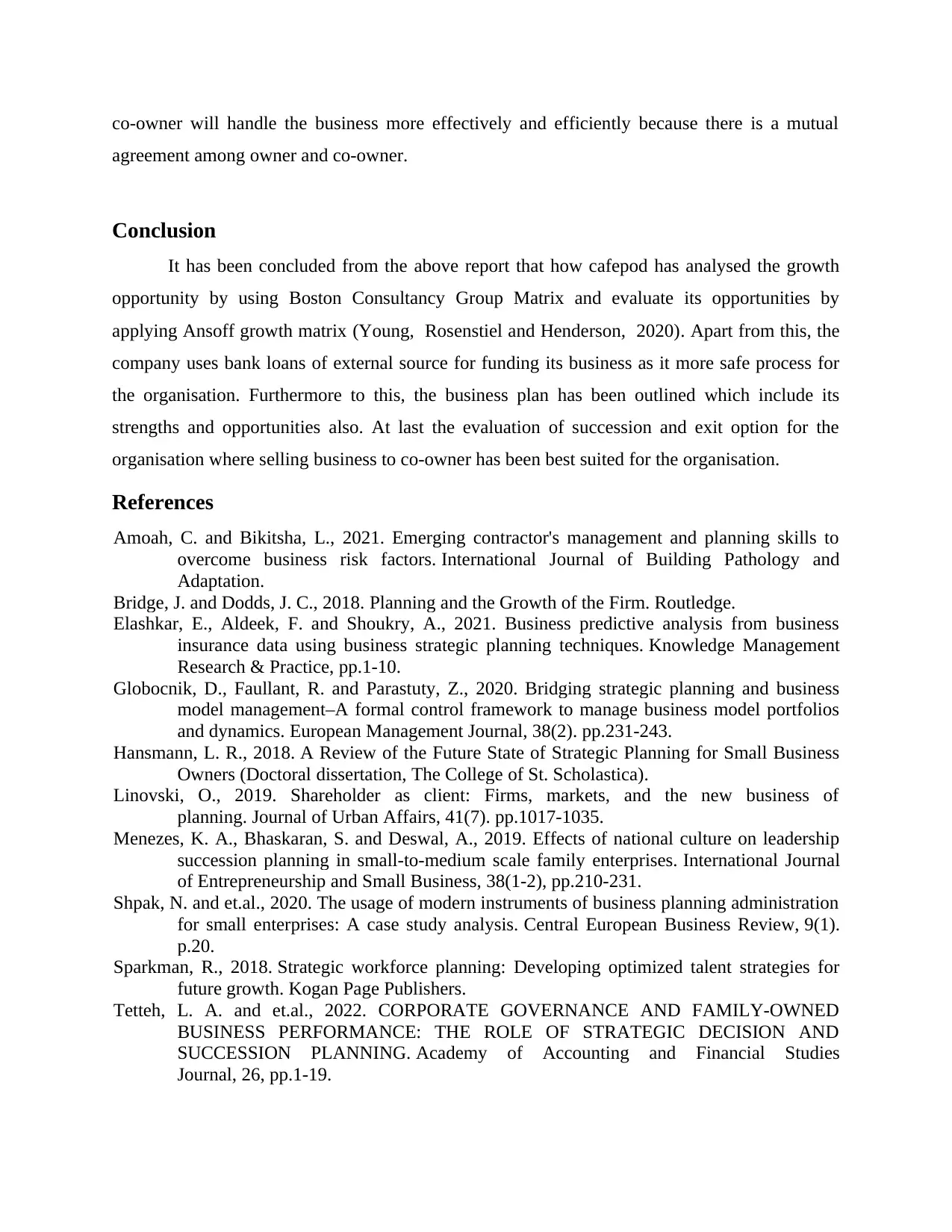
co-owner will handle the business more effectively and efficiently because there is a mutual
agreement among owner and co-owner.
Conclusion
It has been concluded from the above report that how cafepod has analysed the growth
opportunity by using Boston Consultancy Group Matrix and evaluate its opportunities by
applying Ansoff growth matrix (Young, Rosenstiel and Henderson, 2020). Apart from this, the
company uses bank loans of external source for funding its business as it more safe process for
the organisation. Furthermore to this, the business plan has been outlined which include its
strengths and opportunities also. At last the evaluation of succession and exit option for the
organisation where selling business to co-owner has been best suited for the organisation.
References
Amoah, C. and Bikitsha, L., 2021. Emerging contractor's management and planning skills to
overcome business risk factors. International Journal of Building Pathology and
Adaptation.
Bridge, J. and Dodds, J. C., 2018. Planning and the Growth of the Firm. Routledge.
Elashkar, E., Aldeek, F. and Shoukry, A., 2021. Business predictive analysis from business
insurance data using business strategic planning techniques. Knowledge Management
Research & Practice, pp.1-10.
Globocnik, D., Faullant, R. and Parastuty, Z., 2020. Bridging strategic planning and business
model management–A formal control framework to manage business model portfolios
and dynamics. European Management Journal, 38(2). pp.231-243.
Hansmann, L. R., 2018. A Review of the Future State of Strategic Planning for Small Business
Owners (Doctoral dissertation, The College of St. Scholastica).
Linovski, O., 2019. Shareholder as client: Firms, markets, and the new business of
planning. Journal of Urban Affairs, 41(7). pp.1017-1035.
Menezes, K. A., Bhaskaran, S. and Deswal, A., 2019. Effects of national culture on leadership
succession planning in small-to-medium scale family enterprises. International Journal
of Entrepreneurship and Small Business, 38(1-2), pp.210-231.
Shpak, N. and et.al., 2020. The usage of modern instruments of business planning administration
for small enterprises: A case study analysis. Central European Business Review, 9(1).
p.20.
Sparkman, R., 2018. Strategic workforce planning: Developing optimized talent strategies for
future growth. Kogan Page Publishers.
Tetteh, L. A. and et.al., 2022. CORPORATE GOVERNANCE AND FAMILY-OWNED
BUSINESS PERFORMANCE: THE ROLE OF STRATEGIC DECISION AND
SUCCESSION PLANNING. Academy of Accounting and Financial Studies
Journal, 26, pp.1-19.
agreement among owner and co-owner.
Conclusion
It has been concluded from the above report that how cafepod has analysed the growth
opportunity by using Boston Consultancy Group Matrix and evaluate its opportunities by
applying Ansoff growth matrix (Young, Rosenstiel and Henderson, 2020). Apart from this, the
company uses bank loans of external source for funding its business as it more safe process for
the organisation. Furthermore to this, the business plan has been outlined which include its
strengths and opportunities also. At last the evaluation of succession and exit option for the
organisation where selling business to co-owner has been best suited for the organisation.
References
Amoah, C. and Bikitsha, L., 2021. Emerging contractor's management and planning skills to
overcome business risk factors. International Journal of Building Pathology and
Adaptation.
Bridge, J. and Dodds, J. C., 2018. Planning and the Growth of the Firm. Routledge.
Elashkar, E., Aldeek, F. and Shoukry, A., 2021. Business predictive analysis from business
insurance data using business strategic planning techniques. Knowledge Management
Research & Practice, pp.1-10.
Globocnik, D., Faullant, R. and Parastuty, Z., 2020. Bridging strategic planning and business
model management–A formal control framework to manage business model portfolios
and dynamics. European Management Journal, 38(2). pp.231-243.
Hansmann, L. R., 2018. A Review of the Future State of Strategic Planning for Small Business
Owners (Doctoral dissertation, The College of St. Scholastica).
Linovski, O., 2019. Shareholder as client: Firms, markets, and the new business of
planning. Journal of Urban Affairs, 41(7). pp.1017-1035.
Menezes, K. A., Bhaskaran, S. and Deswal, A., 2019. Effects of national culture on leadership
succession planning in small-to-medium scale family enterprises. International Journal
of Entrepreneurship and Small Business, 38(1-2), pp.210-231.
Shpak, N. and et.al., 2020. The usage of modern instruments of business planning administration
for small enterprises: A case study analysis. Central European Business Review, 9(1).
p.20.
Sparkman, R., 2018. Strategic workforce planning: Developing optimized talent strategies for
future growth. Kogan Page Publishers.
Tetteh, L. A. and et.al., 2022. CORPORATE GOVERNANCE AND FAMILY-OWNED
BUSINESS PERFORMANCE: THE ROLE OF STRATEGIC DECISION AND
SUCCESSION PLANNING. Academy of Accounting and Financial Studies
Journal, 26, pp.1-19.
Paraphrase This Document
Need a fresh take? Get an instant paraphrase of this document with our AI Paraphraser
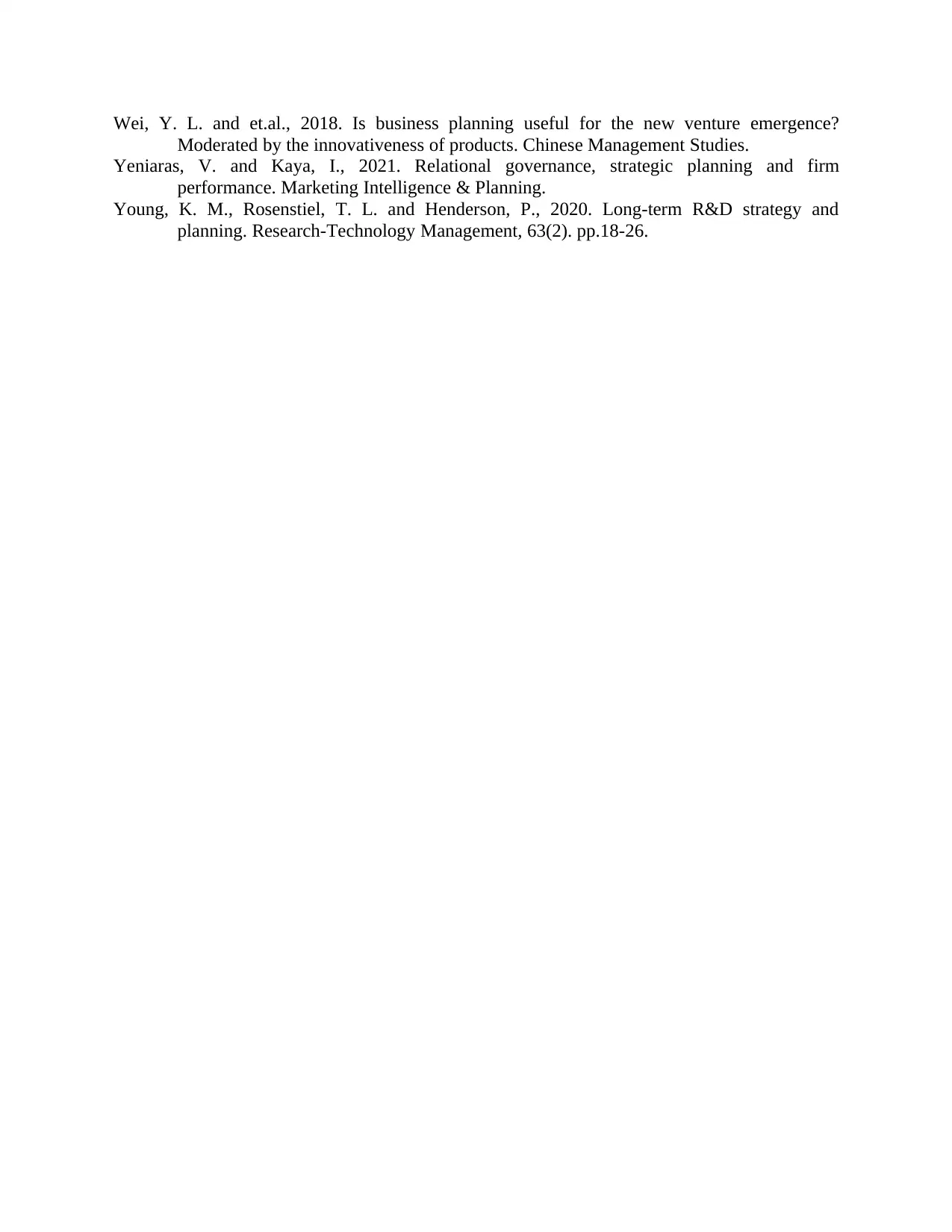
Wei, Y. L. and et.al., 2018. Is business planning useful for the new venture emergence?
Moderated by the innovativeness of products. Chinese Management Studies.
Yeniaras, V. and Kaya, I., 2021. Relational governance, strategic planning and firm
performance. Marketing Intelligence & Planning.
Young, K. M., Rosenstiel, T. L. and Henderson, P., 2020. Long-term R&D strategy and
planning. Research-Technology Management, 63(2). pp.18-26.
Moderated by the innovativeness of products. Chinese Management Studies.
Yeniaras, V. and Kaya, I., 2021. Relational governance, strategic planning and firm
performance. Marketing Intelligence & Planning.
Young, K. M., Rosenstiel, T. L. and Henderson, P., 2020. Long-term R&D strategy and
planning. Research-Technology Management, 63(2). pp.18-26.
1 out of 11
Related Documents
Your All-in-One AI-Powered Toolkit for Academic Success.
+13062052269
info@desklib.com
Available 24*7 on WhatsApp / Email
![[object Object]](/_next/static/media/star-bottom.7253800d.svg)
Unlock your academic potential
Copyright © 2020–2025 A2Z Services. All Rights Reserved. Developed and managed by ZUCOL.





